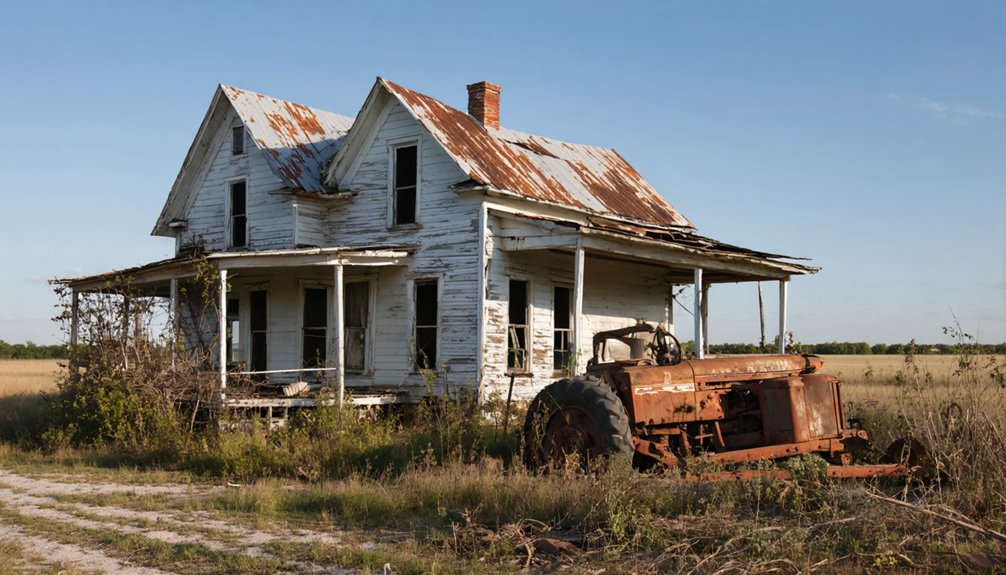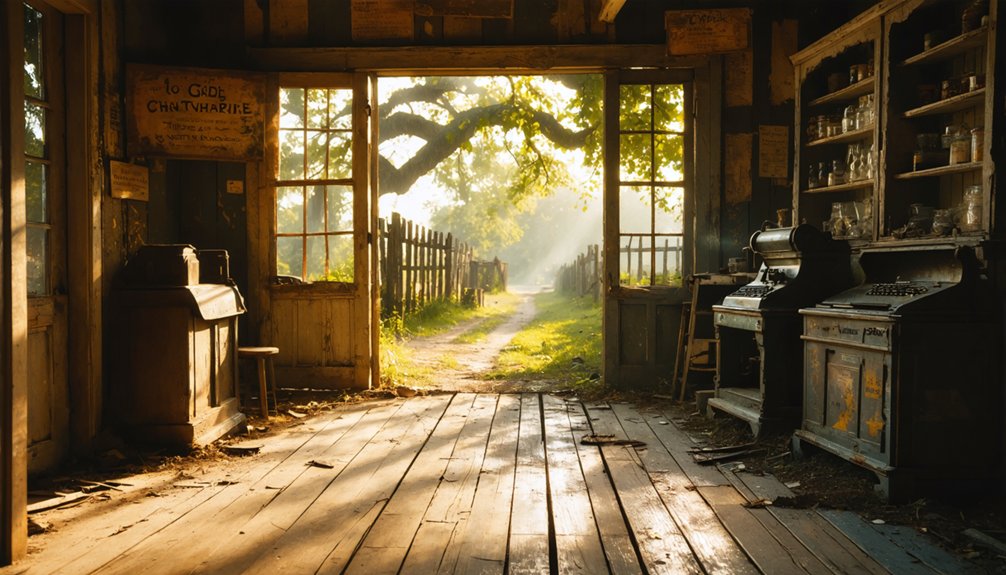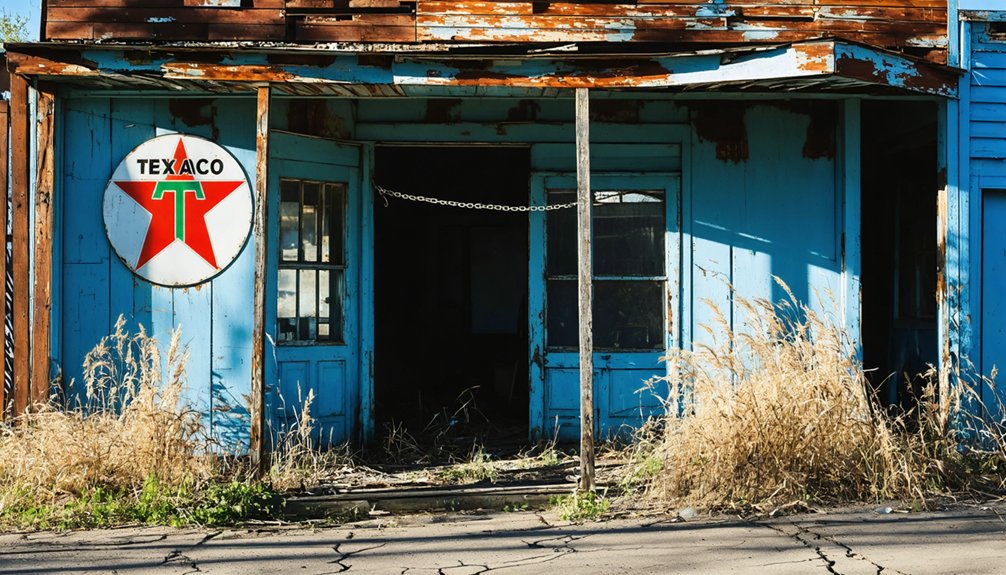You’ll find Knoxville, Texas nestled along the historic Rusk to Tyler Road, where it emerged as a frontier settlement in the late 1840s. Thomas Norman’s land sale in 1854 and William A. Pope’s general store established the town’s commercial foundation, while family farms drove the local economy. Despite its promising start, Knoxville declined in the 1870s as coal mining operations dwindled, eventually becoming a ghost town. Its abandoned structures and rich history hold countless untold stories.
Key Takeaways
- Knoxville, Texas was established in the late 1840s as a frontier settlement with early landowner Thomas Norman selling a significant 30-acre tract.
- The town developed around the Rusk to Tyler Road, with family farms, timber operations, and cotton production driving its early economy.
- Despite modest growth, Knoxville never secured major railroad connections or oil discoveries, limiting its economic development potential.
- Economic decline struck in the 1870s due to failing coal mining operations, leading to mass exodus and infrastructure abandonment.
- The abandoned town now attracts paranormal tourism enthusiasts and preservationists interested in its historical structures and frontier-era legacy.
Origins of a Frontier Settlement
As the American frontier expanded westward in the late 18th century, Knoxville emerged as a strategically placed settlement and capital of the Southwest Territory in 1791.
You’ll find its roots in James White’s fort and mill, established around 1785-1786, which formed the heart of what would become downtown Knoxville. White donated the land that established Knoxville as a city.
The settlement’s location wasn’t random – it reflected careful frontier diplomacy with the Cherokee, culminating in the Treaty of Holston.
Governor William Blount negotiated with 41 Cherokee chiefs to secure the land, though settlement challenges forced planners to adjust when the Cherokee wouldn’t cede the confluence of the Clinch and Tennessee rivers.
The fate of early Knoxville hinged on delicate negotiations between Governor Blount and Cherokee leaders over territorial boundaries.
Charles McClung’s survey divided the town into 64 half-acre lots, with eight dedicated to government functions, setting the stage for Knoxville’s role as a territorial administrative center. Mail carriers faced extreme danger while delivering correspondence, earning fifty dollars per trip.
Early Pioneers and Town Founders
The late 1840s brought a wave of pioneering families to Knoxville, Texas, primarily migrating from their Tennessee homeland. These early settlers faced pioneer struggles as they established farms and traded locally to sustain their community.
You’ll find Thomas Norman among the notable first landowners, who shaped the town’s development by selling a significant portion of his 30-acre tract in 1854. William A. Pope opened the first general store that same year, establishing an important commercial hub for the growing settlement.
As Knoxville evolved beyond its frontier roots, William Whipple Johnson and Harvey Johnson emerged as key figures who tackled founding challenges. The Johnsons would later establish a company town in Thurber by December 1886.
They spearheaded the town’s industrial growth through mining operations, transforming Knoxville from an agricultural settlement into a more diverse economy. Their entrepreneurial vision attracted skilled workers, including brick masons and miners, while maintaining the close-knit social fabric typical of Texas frontier communities.
Life Along the Rusk to Tyler Road
While frontier settlements dotted Cherokee County in the mid-1800s, the Rusk to Tyler Road emerged as a significant commercial artery that shaped life throughout East Texas.
You’d find a vibrant tapestry of commerce and community along this essential route, where trade routes converged at strategic points like Knoxville. Community gatherings at places like Union Chapel Church, which doubled as a school, strengthened the bonds between scattered homesteads and settlements. Early immigrants from the American South helped establish these thriving communities in the 1850s.
- Merchants and blacksmiths set up shop along the road, creating hubs of activity
- Seasonal markets and fairs drew people together for commerce and celebration
- Timber and cotton moved steadily by wagon before railroads arrived
- Churches and schools served as anchors for social life
The road’s influence extended beyond mere transportation, weaving together the fabric of frontier society through commerce and connection. The arrival of the Tyler Tap Railroad in 1871 forever changed the region’s trading patterns and transportation networks.
The White Mansion Legacy
You’ll find the architectural grandeur of the White Mansion reflected in its Greek Revival columns and wraparound veranda, which have stood since its construction by the prominent White family in 1856.
The White family’s influence extended beyond their mansion’s walls, as they established several successful cotton plantations and helped develop the Rusk to Tyler transportation corridor during the mid-19th century. The family patriarch followed a tradition of diplomatic relations, having been known as a friend to Cherokee tribes in earlier settlements.
While portions of the mansion have deteriorated over time, recent preservation efforts have focused on stabilizing the foundation and restoring the original pine flooring that once hosted East Texas’ most notable social gatherings. Following a similar preservation pattern, the James White Fort Association was established as a nonprofit organization to oversee reconstruction efforts of historical structures in the region.
Mansion’s Architectural Heritage
Standing as one of East Tennessee’s earliest frame houses, White Mansion showcases pioneering architectural elements from the late 18th century.
You’ll discover its post and beam construction featuring wide board beaded paneling, reflecting the skilled craftsmanship of frontier builders. The mansion’s architectural significance lies in its seamless blend of early American construction techniques and later Greek Revival influences, evident in the shouldered architrave door surrounds added during expansions. Like many structures of the era, it reflects the design principles of Thomas Hope’s influence, as seen in similar historic houses of the region. The sleeping quarters upstairs could comfortably accommodate up to twenty-five visitors and family members.
- Original 1786 log structure evolved through strategic additions while maintaining stylistic unity
- Features a practical dog trot breezeway connecting the main house to kitchen spaces
- Incorporates period-specific defensive elements like stockade fencing
- Restoration work preserved historical integrity while meeting modern preservation challenges
The mansion’s design elements tell the story of early American settlement life, from its self-sufficient workshop spaces to its adaptation to East Tennessee’s climate.
White Family’s Lasting Impact
Since the 1780s, James White and his descendants have profoundly shaped the development of both Knoxville, Tennessee and its Texas namesake through their civic leadership and economic ventures.
The White family’s social legacy spans generations, from James White’s frontier diplomacy with Native Americans to their extensive agricultural roots in tobacco farming and orchard management.
You’ll find their economic impact reflected in ventures like the White Furniture Company and various mercantile enterprises.
Their political influence extended through multiple offices, with James White serving as Tennessee Senate speaker and militia general.
The family’s cultural contributions include land donations for educational institutions and civic buildings, while their agricultural operations helped establish the region’s economic foundation.
Their intermarriage with prominent families further cemented their lasting impact on both communities.
Historic Restoration Progress
The ambitious restoration of the historic Eugenia Williams House began with extensive exterior work, transforming decades of neglect into a promising cultural landmark.
Historic preservation teams meticulously cleaned and reinstalled original terracotta roof shingles while tackling restoration challenges on the dark brown brick façade.
You’ll find the 24-acre estate now features cleared grounds, revealing hidden trails and stunning Tennessee River views.
- Custom kitchen island crafted from pre-Industrial Revolution wood combines history with modern function
- Interior renovations opened the attic into a 14-foot ceiling second story
- New windows enhance both lighting and energy efficiency
- Period-appropriate lighting fixtures maintain historical authenticity
Economic Rise and Development
During the late 1840s, Knoxville emerged as a frontier settlement when families from Tennessee established roots in the fertile lands of East Texas.
You’ll find that early land transactions, like Thomas Norman’s sale of a two-thirds interest in a 30-acre tract in 1854, laid the groundwork for economic sustainability.
The town’s agricultural foundation centered on family-run farms, where crop cultivation and livestock rearing drove the local economy.
While nearby communities saw agricultural innovation through modernized cotton gins, Knoxville’s growth remained modest.
Without major rail connections or oil discoveries that propelled other Texas towns to prosperity, Knoxville maintained its rural character.
The community’s economic significance relied on local trade networks and road connections to Cherokee County markets.
Signs of Decline and Abandonment

After decades of modest prosperity, Knoxville’s decline became evident in the 1870s as coal mining operations dwindled and economic opportunities vanished.
Like countless mining towns before it, Knoxville withered when the coal seams ran dry and prosperity fled.
The rapid economic downturn triggered a mass exodus, leaving abandoned structures to deteriorate under nature’s relentless assault. Infrastructure neglect soon followed as public services ceased and transportation links were severed.
- You’ll find former company stores and railroad depots now reduced to weathered ruins.
- You can spot environmental reclamation in action as vegetation reclaims streets and yards.
- You’ll notice how population decline transformed this once-bustling town into a genuine ghost town.
- You can explore historical preservation challenges amid crumbling foundations and collapsed roofs.
Today, if you visit Knoxville, you’ll witness the haunting remnants of a community that time forgot, where wildlife roams freely through the skeletal remains of a once-thriving Texas town.
Preservation Efforts Today
You’ll find several preservation organizations working to document and protect Knoxville’s remaining historical structures through collaborative initiatives and funding campaigns.
Community support has grown through local nonprofit partnerships and educational outreach programs that raise awareness about the ghost town’s significance.
Tax incentives and preservation grants now provide critical financial backing for restoration projects, while historic overlay zoning proposals aim to prevent further deterioration of key sites.
Current Restoration Projects
While Knoxville’s ghost town structures have weathered decades of neglect, current preservation efforts combine federal grants, private investments, and local funding to breathe new life into the historic site.
You’ll find restoration funding being directed toward critical infrastructure upgrades, including ADA-compliant sidewalks and improved accessibility. Local preservation groups are leading cabin stabilization projects using historically accurate preservation techniques and traditional craftsmanship.
- Federal grants support pedestrian bridge construction and sidewalk improvements
- Private investors focus on restoring historic cabins and structures with authentic materials
- Underground utility line relocation protects the site’s visual character
- Community endowments fund cemetery maintenance and interpretive signage
These coordinated efforts guarantee Knoxville’s heritage remains intact while making the site more accessible to modern visitors.
The projects balance historic authenticity with necessary safety and infrastructure improvements.
Community Support Initiatives
Today’s preservation efforts in Knoxville benefit from robust community support initiatives that span multiple approaches.
You’ll find active community engagement through volunteer-driven clean-up projects at historic sites and cemeteries, while educational workshops and tours boost preservation awareness among residents. Local partnerships have proven essential, with organizations like Knox Heritage collaborating with botanical gardens and nonprofits to secure critical funding for restoration work.
The annual “Fragile & Fading” lists highlight at-risk historic sites, mobilizing public support for protective measures. You can participate in preservation forums and panel discussions to help shape preservation priorities.
Through partnerships with violence interruption groups and local schools, the preservation movement has expanded its reach, integrating social justice concerns while fostering research opportunities and service learning connected to Knoxville’s historic fabric.
Historical Documentation Progress
Historical documentation of Knoxville has evolved from scattered records to a more structured preservation effort.
You’ll find key documentation in the Cherokee County histories published in 1934 and 1986, which provide essential insights into the town’s development and decline.
Despite documentation challenges, the Texas State Historical Association maintains thorough records that help establish historical accuracy through land transactions and newspaper archives.
- Primary source materials, including Thomas Norman’s 1854 land sale records
- Digital preservation through state historical commission databases
- Academic research focusing on economic and social decline factors
- Online platforms mapping and cataloging ghost town data
While physical remains are scarce, ongoing efforts to digitize and preserve Knoxville’s history guarantee its story won’t be forgotten.
The combination of traditional archives and modern digital preservation helps reconstruct this fascinating chapter of Texas history.
Historical Significance in East Texas
Located along the essential Rusk to Tyler Road, Knoxville emerged as a strategic settlement in East Texas during the 19th century.
You’ll find its history deeply intertwined with the region’s early transportation routes, as the town served as a critical link between major East Texas communities. Initially, this positioning helped Knoxville attract settlers and foster local commerce.
However, the town’s significance diminished as economic shifts transformed the region. When railroads became the dominant mode of transportation, nearby communities like Kilraven adapted by relocating closer to rail lines.
Knoxville couldn’t maintain its commercial importance without rail access, and its economy, primarily based on agriculture and timber, began to decline. The town’s eventual abandonment reflected a broader pattern of change in East Texas, where transportation access often determined a community’s survival.
The Ghost Town’s Lasting Impact

Despite its abandonment, Knoxville’s legacy continues to shape East Texas culture through its rich folklore and historical significance.
Though its streets lie empty, Knoxville’s spirit endures in the stories and traditions that define East Texas heritage.
You’ll discover how this ghost town has evolved into a hub for paranormal tourism while strengthening the region’s cultural identity. The town’s eerie past now serves as a catalyst for heritage conservation and community engagement, with local historians leading walking tours and preserving oral histories that connect you to the frontier era.
- Experience spine-tingling ghost stories of murder, revenge, and supernatural phenomena
- Join guided tours led by knowledgeable historians who bring the past to life
- Explore the town’s role in social reforms and frontier challenges
- Support local heritage conservation efforts while diving into Texas history
Through historical awareness and active preservation, Knoxville’s impact resonates far beyond its physical remains, offering you a unique window into East Texas’ fascinating past.
Frequently Asked Questions
Are There Any Reported Ghost Sightings or Paranormal Activity in Knoxville?
You’ll find numerous ghost legends throughout the city, from spectral sightings at Old Gray Cemetery to Civil War soldiers in historic buildings, shadow people in Market Square, and unexplained phenomena at the City County Building.
What Happened to the Original Residents When They Left Knoxville?
Like scattered seeds in the wind, you’ll find Knoxville’s original residents moved to nearby towns – especially Rusk and Tyler – seeking better economic opportunities, while maintaining social ties through family connections.
Can Visitors Access the Town Site Today Without Special Permission?
You can’t access this ghost town site without special permissions today. Current visitor regulations prohibit unauthorized entry since it’s likely on private property, and there’s no established public access infrastructure.
Were There Any Notable Crimes or Incidents During Knoxville’s Active Years?
You’ll shudder at Knoxville’s blood-soaked crime history, which included countless gunfights, murders, and lynch mob incidents. The Bowery district became particularly infamous for violent acts during the late 1800s.
What Native American Artifacts Have Been Discovered in the Knoxville Area?
You’ll find stone tools, incised lithic art, ceremonial pipes, and traded pottery from Caddo peoples, showing Native American artifact preservation of both practical items and symbolic pieces from distant regions.
References
- https://texashighways.com/travel-news/four-texas-ghost-towns/
- https://discovertexasoutdoors.com/places/knoxville-texas-a-historic-ghost-town-in-cherokee-county/
- http://texasghosttowns.blogspot.com/2012/12/gilliland-knox-county-december-2012.html
- https://search.aic.edu/dwd/mystery-of-the-abandoned-knoxville-mansion-what-happened-to-its-owners
- https://en.wikipedia.org/wiki/List_of_ghost_towns_in_Texas
- https://en.wikipedia.org/wiki/Noxville
- https://www.texasescapes.com/TOWNS/Texas_ghost_towns.htm
- https://www.tshaonline.org/handbook/entries/knoxville-tx
- https://en.wikipedia.org/wiki/History_of_Knoxville
- https://www.knoxcountylibrary.org/the-founding-of-knox-county



